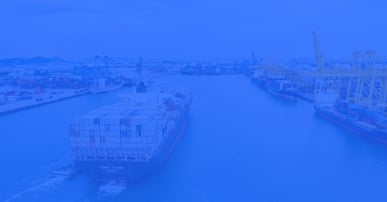
On July 1, the Safety of Life at Sea (SOLAS) amendment requiring packed containers to be properly weighed and verified before being loaded on board a vessel went into effect globally. Shippers, ports, container lines and others all noted few disruptions, but rumblings of additional charges from some terminals, liners and forwarders raised concern from shippers. In our latest weekly survey, we polled our social media followers to ask how they report cargo VGM (Verified Gross Mass).
Reporting via Forwarders Leads the Way
Three months into the required mandate, we polled social media followers to ask how they report cargo VGM (Verified Gross Mass). The results were not all together surprising with 44% indicating they report cargo VGM via their freight forwarder, 33% by way of INTTRA and 22% direct with a carrier.
For those folks indicating they use a freight forwarder to submit VGM report data, it’s likely these freight forwarders are using platforms such as INTTRA.
Leading Tool For A VGM Report is INTTRA
According to its website, INTTRA is an electronic transaction platform and information provider for the ocean shipping industry. Customers can book and track containers and submit shipping instructions within the industry’s largest e-commerce network, gaining access to 54 carriers and NVOCCs. Indeed, among INTTRA’s customers using its VGM tool include container lines such as HMM, COSCO Container Lines, NYK Line, Zim, Hapag-Lloyd and MSC. Freight forwarders including DB Schenker and Kuehne + Nagel are also using INTTRA’s VGM tool to submit the required data.
INTTRA is Not the Only Tool
But INTTRA is certainly not the only tool; CargoSmart and GT Nexus also offer tools to submit VGM data. Nippon Express, Globaltransol and ACX Global opted to use CargoSmart while large companies such as Nestle utilize GT Nexus.
Grace Period Proved Helpful
Even though July 1 was the first day of the mandate, the International Maritime Organization (IMO) requested authorities to adopt a ‘practical and pragmatic’ approach to SOLAS VGM by way of a three- month grace period. This grace period ended October 1 and based on feedback from various container terminals, the compliance rate is estimated at about 95% according to the World Shipping Council. Robert Keen, director general of the British International Freight Association (BIFA) three-month grace period has provided some flexibility, helping all the stakeholders in containerized transport to refine procedures for documenting, communicating and sharing electronic verified gross mass data.
The grace period allowed for collaboration between all involved and appears to have made a significant impact on a mandate that many shippers, ports, container lines and others previously expressed concerned over lack of guidance from entities requiring this rule.
How successful have you been with VGM report requirements? Join the discussion leave your comment below:


-1.jpg)



